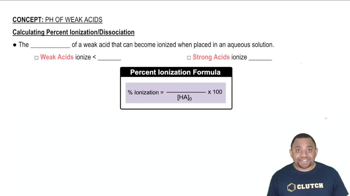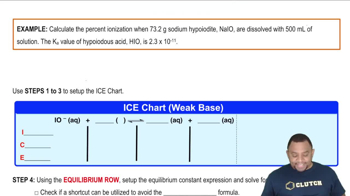Here are the essential concepts you must grasp in order to answer the question correctly.
Weak Acid Ionization
Weak acids do not completely dissociate in solution, which means only a fraction of the acid molecules release protons (H+). The extent of this ionization is quantified by the acid dissociation constant (Ka), which indicates the strength of the acid. A lower Ka value corresponds to a weaker acid and less ionization, while a higher Ka indicates a stronger acid with greater ionization.
Recommended video:
Calculating Percent Ionization of Weak Acids
pH Calculation
The pH of a solution is a measure of its acidity, calculated using the formula pH = -log[H+], where [H+] is the concentration of hydrogen ions in the solution. For weak acids, the concentration of H+ can be determined from the equilibrium expression derived from the acid dissociation constant (Ka) and the initial concentration of the acid. Understanding how to set up and solve this equilibrium expression is crucial for calculating pH.
Recommended video:
Percent Ionization
Percent ionization is a way to express the degree to which a weak acid dissociates in solution, calculated as (amount of acid ionized / initial concentration of acid) × 100%. This value provides insight into the strength of the acid; a higher percent ionization indicates a stronger acid. It is particularly useful for comparing the ionization of acids with different Ka values in similar concentrations.
Recommended video:
Percent Ionization Example

 Verified step by step guidance
Verified step by step guidance

